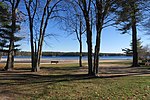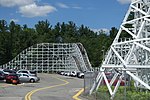Arlington Mill Reservoir
Lakes of Rockingham County, New HampshireNew Hampshire geography stubsReservoirs in New Hampshire

Arlington Mill Reservoir, known locally as "Arlington Pond", is a 269-acre (109 ha) impoundment located in Rockingham County in southern New Hampshire, United States, in the town of Salem. It is located along the Spicket River, a small stream that flows south to the Merrimack River in Lawrence, Massachusetts. The lake is classified as a warmwater fishery, with observed species including smallmouth bass, largemouth bass, chain pickerel, horned pout, white perch, black crappie, and bluegill. There is no public boat access.
Excerpt from the Wikipedia article Arlington Mill Reservoir (License: CC BY-SA 3.0, Authors, Images).Arlington Mill Reservoir
Shore Drive,
Geographical coordinates (GPS) Address Nearby Places Show on map
Geographical coordinates (GPS)
| Latitude | Longitude |
|---|---|
| N 42.825555555556 ° | E -71.213888888889 ° |
Address
Shore Drive 209
03079
New Hampshire, United States
Open on Google Maps










